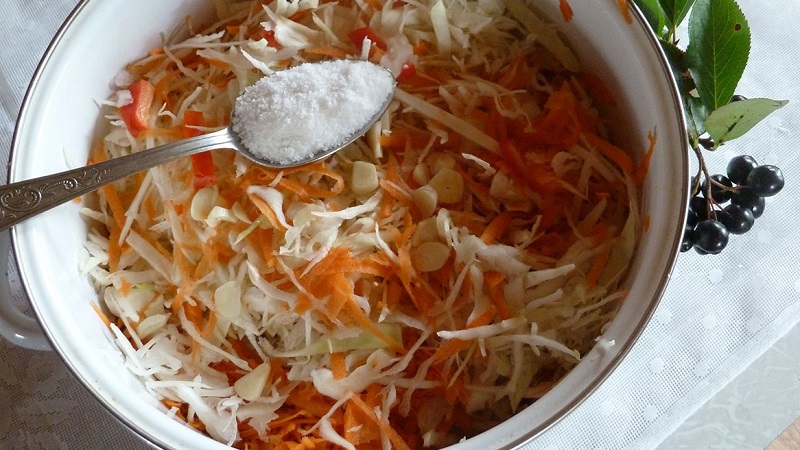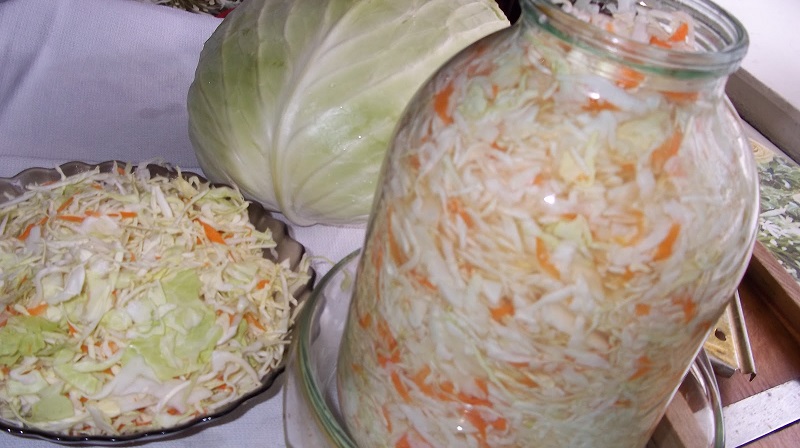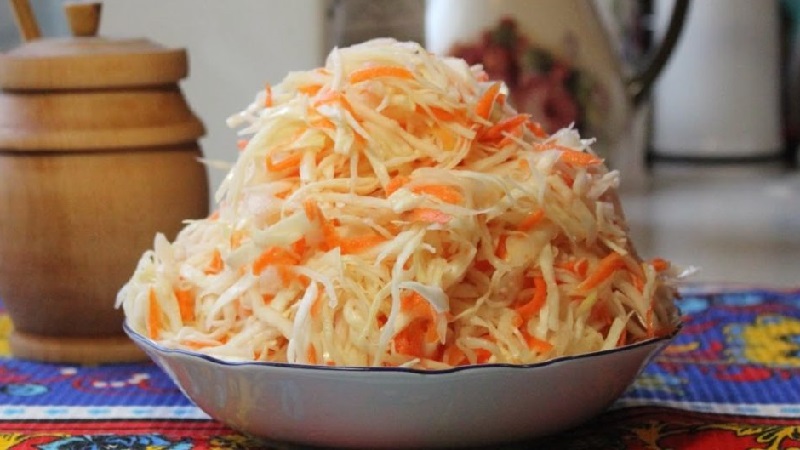Correcting shortcomings in the preparation: how to remove bitterness from sauerkraut and why it appears
It happens that ready-made sauerkraut disappoints housewives with a bitter taste. If a slight bitterness appears due to a poorly selected variety, this is not so bad, but excessive bitterness means that the dish is spoiled and not suitable for eating.
We will talk further about why salted and sauerkraut are bitter and what to do to avoid this problem.
The content of the article
Why sauerkraut is bitter
A healthy, vitamin dish prepared without heat treatment will saturate the body with nutrients and trace elements in the cold season.
Sauerkraut is an appetizing addition to a family dinner or a festive table, an alternative to fresh vegetables, which are expensive in winter and not always of acceptable quality. Let's talk about the causes of bitterness.
Cabbage was not pierced
In the process of salting cabbage, an acidic environment is formed inside the jar (barrel)... This occurs as a result of the interaction of cabbage juice With salt, the fermentation process begins with the release of a large amount of gases.
If they do not come out, they accumulate in containers between the layers of cabbage, causing a bitter taste.

After stacking in a jar the workpiece is pierced with a wooden stick to the very bottom... Repeat this procedure 1-2 times a day until the product is completely ready.
Council. During fermentation, experienced housewives leave a wooden stick in the center of the container - it prevents the formation of an unpleasant odor and improves the taste of cabbage.
A lot or little salt
One of the common causes of a bitter taste is too much salt... Due to the excess of this ingredient, lactic acid bacteria die, as a result of which the fermentation process stops. The salting technology is violated, the foam does not appear in the jar, indicating the correct fermentation. Cabbage loses its attractive light shade, becomes grayish and bitter.
Lack of salt also negatively affects the taste of sauerkraut.... Active fermentation is obtained only by the interaction of salt and secreted juice. With a shortage of the first component in the container, harmful bacteria are formed instead of useful ones, the process of decay begins.
Important! The lack of salt is evidenced by a viscous bloom, clearly visible on top of the cabbage mass, as well as the excessive softness of the product. To ferment 10 kg of cabbage in the classic recipe, 200 g of common table salt is required.

Wrong variety of cabbage
All varieties are divided depending on the timing of their ripening. Experienced housewives know rules for choosing white cabbage for fermentation:
- early varieties are not used, they do not form a sufficient amount of sugars necessary for fermentation, and the tender leaves of the vegetable, when salted, become soft and tasteless;
- mid-season varieties are fermented in the northern, cold regions, since late cabbage does not have time to ripen in a short summer - the leaves are relatively hard and elastic, there is enough sugar in them, but the taste of the finished product is not too pronounced;
- late varieties are an ideal choice for fermentation, the heads of cabbage become crispy, juicy, saturated with vitamins and useful microelements by autumn.
Chosen for pickling forks is immediately tasted when sliced... There are specimens that have fresh bitterness.
Interesting on the site:
Proper storage of sauerkraut in the refrigerator
The following varieties and hybrids are considered the most suitable for fermentation:
- Menza F1;
- Dobrovodskaya:
- Belarusian;
- Glory 1305
- Snow White;
- Mara;
- Kharkov winter;
- Turkiz;
- Present.
When preparing heads of cabbage, the upper green leaves are removed from them.... The lightest and most elastic leaves are suitable for fermentation.

Nitrates
Unnatural bitterness for sauerkraut appears as a result accumulations of dangerous nitrates in vegetables, which are actively absorbed from the soil. A crop saturated with harmful additives and chemicals is harmful to the body.
Reference. In the process of growing, a number of other mistakes are made - insufficient watering or overflow, as a result of which the forks become unsuitable for storage and fermentation.
Late harvest
For salting, use only fully ripe varieties... Specimens removed from the garden in time are characterized by looseness and insufficient elasticity. Cut the cabbage no later than 1-2 days after the onset of the first frost. By this time, the vegetable is considered fully ripe.
When lightly squeezing the head of cabbage, a slight crackling is heard, and it itself has a white tint - this means that the optimal amount of sugars has accumulated in the forks.
Before salting, the harvested crop is placed in a cellar or storage room for 12-14 days, during this period he will finally gain maturity.
Is it possible to eat sauerkraut if it tastes bitter
The finished product with a slight bitterness is suitable for human consumption, however, this taste does not suit everyone.
Such a product does not represent a health hazard, but many housewives are trying to get rid of the bitter taste in affordable ways and save the vitamin preparation.
How to remove bitterness from sauerkraut
To avoid spoilage of the product, housewives try not to violate the cooking technology. AND thanks to some tricks, the taste is slightly improved:
- before eating ready-made cabbage, put it on a plate for 2-3 hours at room conditions, stirring occasionally to improve air circulation;
- a fragrant snack is prepared from cabbage with the addition of pickled onions, a pinch of sugar and vinegar, mixed with vegetable oil;
- drain the liquid from the jar, squeeze the cabbage mass, and then pour it in with freshly prepared brine from water, sugar and salt (the taste will not deteriorate, but the aroma will become much weaker).
If bitterness is detected even before the end of salting, the cabbage is thoroughly mixed and the lid is removed... Accumulated gases will more easily escape from an open container. Store it in a cool place.

Tips for fermenting cabbage without bitterness
To prevent cabbage from becoming bitter after salting, it should not be washed in warm or hot water before shredding.... The heads of cabbage are rinsed only under running cold water, and then cut.
It is more convenient to pickle cabbage in three-liter jars... In large barrels and tubs, the product is less well stored and often deteriorates before it can be eaten. For sourdough, use only regular salt, not iodized.
Experienced chefs resort to tricks to prevent bitterness:
- to improve the taste of cabbage, not only salt is added to the sourdough, but also allspice, horseradish, carrots and spices;
- before cutting, the head of cabbage is soaked in cool water for 30-40 minutes;
- the brine is poured so that it covers the entire laid mass.
A few leaves of horseradish in a container with cabbage will prevent mold from forming... The optimal storage temperature for salting is from 20 to 23 ° C.
Conclusion
Sauerkraut is one of the most popular dishes in Russian cuisine. Tasty, aromatic, crispy and juicy, it retains all vitamins and useful components in winter.The product is suitable for serving with hot side dishes, as well as a stand-alone snack with black or white bread.
The optimal amount of salt, suitable temperature conditions, the obligatory mixing and piercing of the cabbage mass to release gases - these are the simple conditions, the observance of which will help to prepare the perfect sauerkraut.